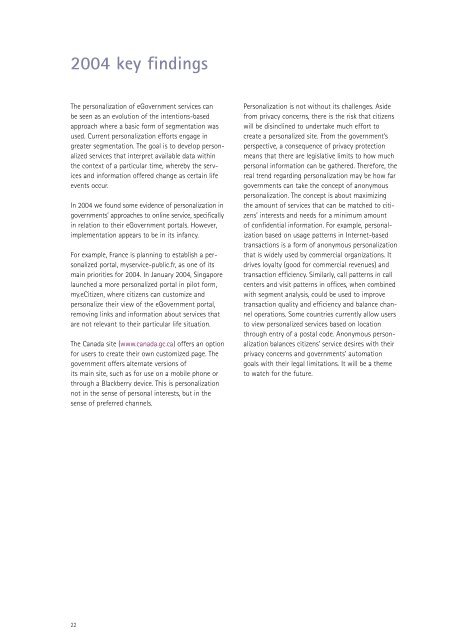Accenture's fifth annual global e-government study
Accenture's fifth annual global e-government study
Accenture's fifth annual global e-government study
You also want an ePaper? Increase the reach of your titles
YUMPU automatically turns print PDFs into web optimized ePapers that Google loves.
2004 key findings<br />
The personalization of eGovernment services can<br />
be seen as an evolution of the intentions-based<br />
approach where a basic form of segmentation was<br />
used. Current personalization efforts engage in<br />
greater segmentation. The goal is to develop personalized<br />
services that interpret available data within<br />
the context of a particular time, whereby the services<br />
and information offered change as certain life<br />
events occur.<br />
In 2004 we found some evidence of personalization in<br />
<strong>government</strong>s’ approaches to online service, specifically<br />
in relation to their eGovernment portals. However,<br />
implementation appears to be in its infancy.<br />
For example, France is planning to establish a personalized<br />
portal, myservice-public.fr, as one of its<br />
main priorities for 2004. In January 2004, Singapore<br />
launched a more personalized portal in pilot form,<br />
my.eCitizen, where citizens can customize and<br />
personalize their view of the eGovernment portal,<br />
removing links and information about services that<br />
are not relevant to their particular life situation.<br />
The Canada site (www.canada.gc.ca) offers an option<br />
for users to create their own customized page. The<br />
<strong>government</strong> offers alternate versions of<br />
its main site, such as for use on a mobile phone or<br />
through a Blackberry device. This is personalization<br />
not in the sense of personal interests, but in the<br />
sense of preferred channels.<br />
Personalization is not without its challenges. Aside<br />
from privacy concerns, there is the risk that citizens<br />
will be disinclined to undertake much effort to<br />
create a personalized site. From the <strong>government</strong>’s<br />
perspective, a consequence of privacy protection<br />
means that there are legislative limits to how much<br />
personal information can be gathered. Therefore, the<br />
real trend regarding personalization may be how far<br />
<strong>government</strong>s can take the concept of anonymous<br />
personalization. The concept is about maximizing<br />
the amount of services that can be matched to citizens’<br />
interests and needs for a minimum amount<br />
of confidential information. For example, personalization<br />
based on usage patterns in Internet-based<br />
transactions is a form of anonymous personalization<br />
that is widely used by commercial organizations. It<br />
drives loyalty (good for commercial revenues) and<br />
transaction efficiency. Similarly, call patterns in call<br />
centers and visit patterns in offices, when combined<br />
with segment analysis, could be used to improve<br />
transaction quality and efficiency and balance channel<br />
operations. Some countries currently allow users<br />
to view personalized services based on location<br />
through entry of a postal code. Anonymous personalization<br />
balances citizens’ service desires with their<br />
privacy concerns and <strong>government</strong>s’ automation<br />
goals with their legal limitations. It will be a theme<br />
to watch for the future.<br />
22













